
Supported by a three-year National Science Foundation (NSF) Collaborative Research grant, Associate Professor Michael Shields and Assistant Research Professor Dimitris Giovanis, both in the Whiting School of Engineering’s Department of Civil and Systems Engineering, are part of a team studying how the human brain responds to severe impacts, like those sustained in car crashes, explosions, and head-to-head collisions. The team’s work promises to provide insights into how the brain deforms and is potentially damaged during these events.
Shields and Giovanis are working with Louisiana State University’s Kshitiz Upadhyay and Curtis Johnson from the University of Delaware to fill critical gaps in our understanding of traumatic brain injury (TBI). Led by LSU, the project will be the first to develop comprehensive maps of the living brain’s mechanical properties under extreme conditions.
“Traumatic brain injuries are a significant public health issue, yet scientists still know little about how the brain reacts under extreme conditions. Current knowledge is mostly limited to how the brain behaves during minor impacts, leaving a crucial need for research in more severe scenarios. Our goal is to understand how the brain responds to high-speed, high-impact events,” said Shields, Johns Hopkins’ principal investigator.
The research will be conducted in two phases using advanced imaging techniques. The first phase will test the response of brain tissue samples to minor impacts at varying low-speed rates. In the second phase, the researchers will focus on impacts with greater force and higher speeds, simulating conditions more closely associated with severe TBIs. The data will then be combined and used to develop machine learning models to predict the brain’s behavior under various conditions of impact.
Shields said, “One of the biggest challenges in this field is the ethical limitation on testing brain injuries in living humans. Existing methods rely on non-invasive, low-impact techniques for living test subjects and studies of cadaver brains, which may not accurately represent a living brain’s response. By using the data from these testing methods and augmenting it with machine learning, we hope to make more accurate predictions of brain injuries.”
Ethical limitations of brain research on living subjects also pose a key challenge for this study—it makes conventional data validation approaches impossible.
“We cannot test on living humans without causing harm, so our validation method consists of ensuring that injury predictions from the machine learning model match observable injury responses,” said Giovanis.
Once the model has been developed, the team will begin testing full-head models in various simulated scenarios, enabling a more robust understanding of risks associated with brain injury to inform treatment and injury mitigation.
“At the end of the study, these models will improve our understanding of TBI. We’ll know more about how the brain responds in scenarios that we cannot physically test on a living brain and we’ll have more insights on the risks of cumulative damage,” Shields said.